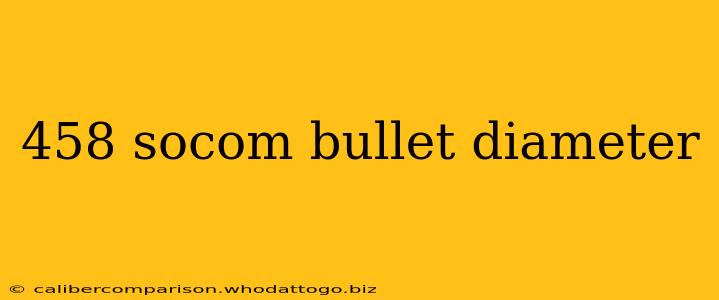The .458 SOCOM cartridge is known for its impressive stopping power, making it a favorite among enthusiasts seeking a powerful round for hunting and self-defense. Understanding its specifications, particularly the bullet diameter, is crucial for responsible firearm ownership and accurate load selection. This article delves into the specifics of the .458 SOCOM bullet diameter, exploring its nuances and implications.
Understanding Bullet Diameter vs. Caliber
Before diving into the specifics of the .458 SOCOM, it's important to clarify the difference between bullet diameter and caliber. While often used interchangeably, they represent distinct measurements:
-
Caliber: This refers to the diameter of the bore (the inside of the gun barrel). It's usually expressed in inches or millimeters.
-
Bullet Diameter: This is the diameter of the projectile itself. While ideally matching the bore diameter, slight variations exist due to manufacturing tolerances and design considerations. This is especially true for lead bullets, which may have slight variations.
The .458 SOCOM Bullet Diameter: The Nominal and the Reality
The nominal caliber of the .458 SOCOM is, as the name suggests, .458 inches. However, the actual bullet diameter might show slight variations depending on the manufacturer and bullet design. You'll generally find bullet diameters ranging from approximately .457 inches to .459 inches. This is within an acceptable range and shouldn't significantly impact performance. However, knowing this variation can aid in bullet selection and understanding potential accuracy considerations.
Factors Influencing Bullet Diameter Variation:
-
Manufacturing tolerances: Slight variations in manufacturing processes are inherent in any mass-produced item, including bullets.
-
Bullet design: The specific design of the bullet, such as its shape, material, and construction, can slightly affect its diameter. For example, a jacketed bullet might have a slightly different diameter than a lead bullet.
-
Measurement methods: Variations can also arise from differences in measurement techniques used by various manufacturers.
Implications of Bullet Diameter Variation
While small variations in bullet diameter usually won't drastically affect performance in the .458 SOCOM, they are worth noting:
-
Accuracy: Minor variations can influence accuracy, particularly at longer ranges. Choosing bullets from a reputable manufacturer with consistent quality control is essential for optimal accuracy.
-
Feeding and Functioning: While uncommon, significant deviations could affect the smooth functioning of the firearm. It's always crucial to use ammunition designed specifically for your firearm model.
-
Lead bullets and rifling: Lead bullets, particularly in heavier weights, might require slightly larger diameters to provide better rifling engagement. Understand the specifics of the bullet and your firearm to prevent leading issues.
Choosing the Right Ammunition
Always consult your firearm's owner's manual for recommended ammunition specifications. Selecting high-quality ammunition from established manufacturers is paramount. This will ensure consistent performance, accuracy, and reliable function within the acceptable tolerances of the .458 SOCOM platform.
Disclaimer: This information is for educational purposes only and should not be considered professional advice. Always consult a qualified firearms expert before handling firearms or ammunition. Safe firearm handling practices are essential.

